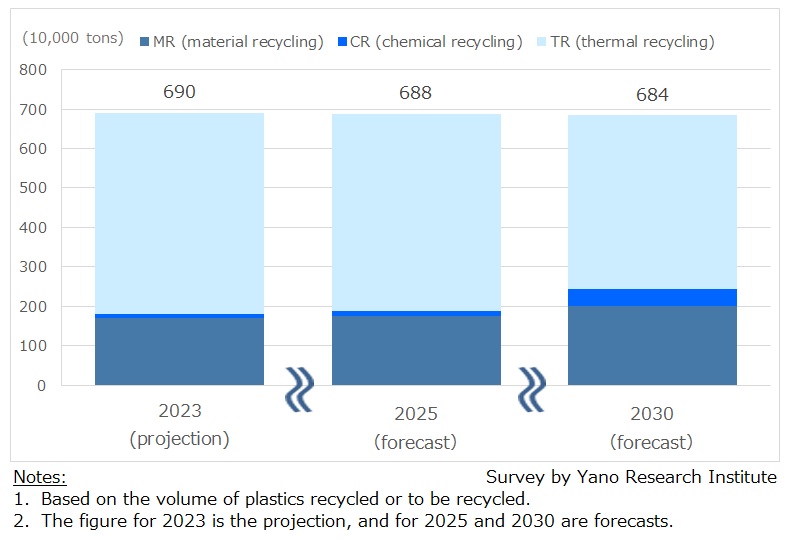No.3438
Plastic Recycling Market in Japan: Key Research Findings 2023
Volume of Plastic Recycled (as a Total of Material Recycling, Chemical Recycling, and Thermal Recycling) in Japan Projected to Attain 6.9 Million Tons in 2023
Yano Research Institute (the President, Takashi Mizukoshi) carried out a survey on plastic recycling trends in Japan, and found out the trends in recycling technologies, market players, and future perspectives.

Market Overview
The volume of recycled plastic in Japan as a total weight of plastics processed through material recycling, chemical recycling, and thermal recycling (may be referred to as MR, CR, and TR hereafter) in 2023 was estimated at 6.9 million tons. In detail, the volume of MR was estimated at 1.7 million tons, CR at 0.1 million tons and TR at 5.1 million tons. In consideration of various global movements starting with EU’s New Circular Economy Action Plan, UN’s adoption of Sustainable Development Goals, and a rising issue of marine plastic litter that causes problems for marine ecosystems, in April 2022, Japan brought Plastic Resource Circulation Act into effect.
So far, a majority of disposed plastics has been reused through TR, the energy recovery, while other materials like transportation packaging are reused by cascade recycling (a type of MR where the material is reused as a material, but its properties are degraded so it never returns to the original material). However, against the backdrop of the recent moves toward resource circulation, CR technologies have been developed and tested, primarily by leading chemical manufacturers who targets to capitalize on these technologies by sometime between 2025 and 2030.
Noteworthy Topics
Recycling Trends by Type of Resin (POs, PET, PS)
Domestic recycling trends by type of resin are as follows:
Polypropylene (PP) collected as municipal waste in the form of home appliances, packaging materials, and household goods are mechanically recycled by recyclers and masterbatch manufacturers. While they are mainly cascade-recycled into transportation packaging and household items like pallets and stationeries, in some cases of home appliance and auto parts (although it is still very limited) collected materials are recycled horizontally (recycled back into original home appliances or auto parts).
Polyethylene (PE) collected as industrial waste and municipal waste, such as films and food packaging, are mechanically recycled by recyclers and masterbatch manufacturers. As PE is cascade-recycled into plastic bags and garbage bags, the situation is similar to that of PP.
Polyethylene terephthalate (PET) collected as PET bottles are horizontally recycled (bottle-to-bottle) or transformed into wide range of applications, such as egg cartons, trays for fruits and vegetables, clothes, automobile, and construction materials. Waste PET bottles are pulverized into flakes, cleansed, and recycled into resin. Approximately 55% of the flakes are reused in production of films, fibers, and molded products instead of bottles. Although horizontal recycling is advancing for PET bottles, with regard to production of recycled films and fibers, neither partnership between recyclers and manufacturers/brand owners nor moves to establish collection system is seen as much.
Polystyrene (PS) collected as municipal waste such as home appliances, food films, food containers and polystyrene foams, are mechanically recycled by recyclers and masterbatch manufacturers. PS is mainly cascade-recycled into transportation packaging and daily necessities/household goods.
Future Outlook
In the domestic plastic market, quite a few chemical manufacturers, recyclers, and masterbatch manufacturers anticipate sophistication of MR method and implementation of CR method by 2030. Still, as the amount of plastic waste will diminish, our forecast on the volume of plastics to be recycled will stay almost flat. Specifically, we project that the volume of waste plastic to be reused through TR will decrease, while those to be reused through MR and CR will increase.
Research Outline
2.Research Object: Recyclers (including manufacturers of recycled resin), pellet and masterbatch manufacturers, chemical manufacturers
3.Research Methogology: Face-to-face interviews (including online interviews) by our expert researchers, and literature research
What is Plastic Recycling Market?
Plastic recycling market in this research refers to the market of material recycling (MR), chemical recycling (CR), and thermal recycling (TR). MR is reusing of collected waste plastics as a raw material to produce new plastic product after the processes of sorting (out from other rubbish), crushing, pulverizing, cleaning, and removing foreign materials. CR is reusing of collected waste plastics as a raw material of a new product after they are chemically decomposed into chemical materials, monomer, oil, gas, etc. TR is effective utilization of collected waste plastics as fuels to generate heat energy. The market size is calculated based on volume (weight-based) of plastics recycled.
In estimation of CR market size, operation rate of plant in the first year is assumed as 50%, excluding the reuse of waste plastics as fuels for blast furnace and coke oven.
<Products and Services in the Market>
Plastic recycling (material recycling, chemical recycling, thermal recycling); horizontal recycling, cascade recycling (open-loop recycling); recycled resin
Published Report
Contact Us
The copyright and all other rights pertaining to this report belong to Yano Research Institute.
Please contact our PR team when quoting the report contents for the purpose other than media coverage.
Depending on the purpose of using our report, we may ask you to present your sentences for confirmation beforehand.